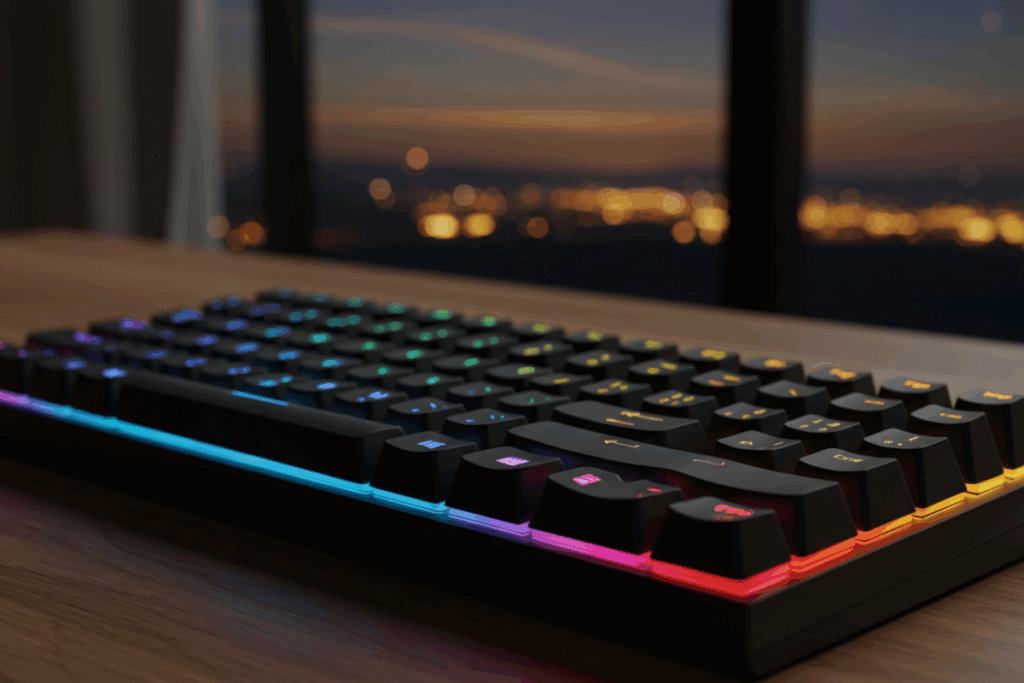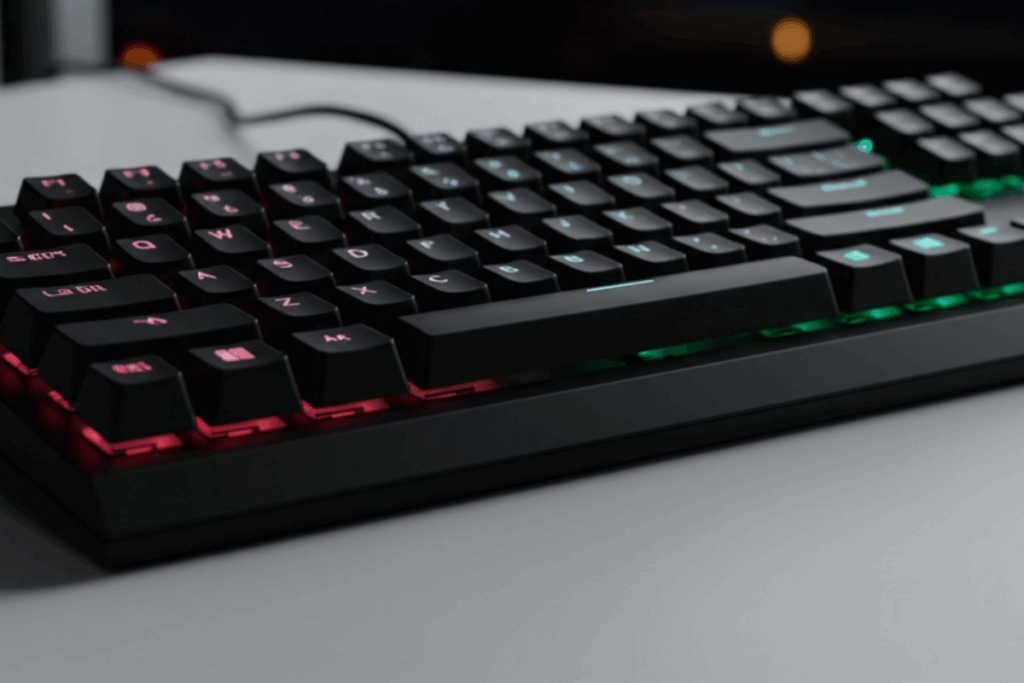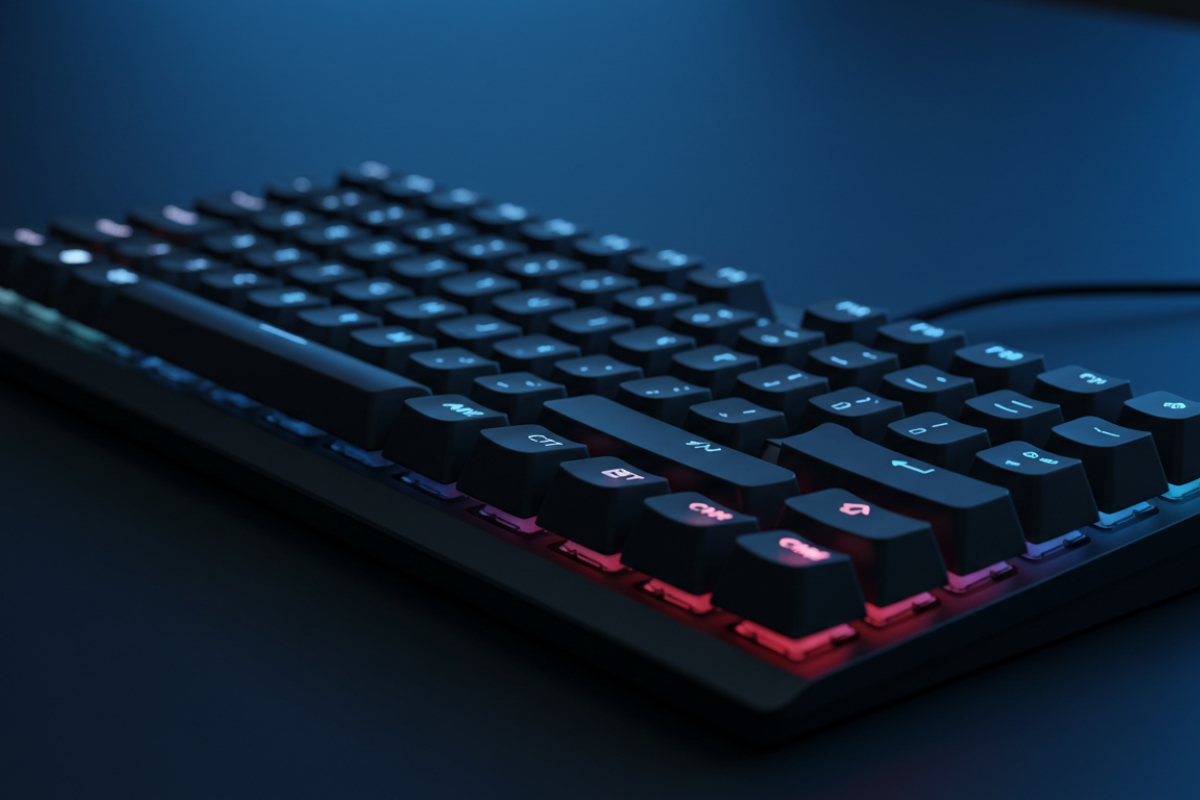Low noise gaming keyboards are my go-to for late-night sessions. I choose them to protect sleep, keep roommates happy, and clean up my stream audio. Below I cover trusted silent switches (mechanical silent, membrane, scissor), practical noise‑reduction tricks (O‑rings, switch lubing, dampening foam), and the real trade‑offs between quiet, feel, durability, and price.
Expect top quiet picks, clear buying tips, and easy mods I use to cut noise fast. As someone who tests gear at Keyboards Technology, I share hands‑on advice so you can pick a quiet board that keeps performance high and neighbors asleep.
Key takeaway
- I test and recommend low noise gaming keyboards that balance silence and performance.
- Favorite switches: Cherry MX Silent, Gateron Silent, Kailh, and Topre.
- Quick mods: lubing, O‑rings, films, and case foam.
- Use dimmable RGB or night mode for late‑night play.
- Check noise level, latency, mod options, and warranty before buying.
Why I choose low noise gaming keyboards for late nights
I play and work late. Loud keys ruin streams, calls, and roommates’ sleep. A low noise gaming keyboard keeps keystrokes out of the mic, helps me stay focused, and avoids complaints. I prefer builds that cut sound without killing feel — that’s more important to me than flashy lighting.
How quiet keys protect sleep and stream audio
- Mechanical switches can reach 50–60 dB; a quiet bedroom sits around 30–40 dB. Silent switches and dampeners push noise toward 30–35 dB, far less likely to disturb sleep.
- For streaming, quieter keys let voice come forward and reduce reliance on heavy noise gates.
- Small mods — O‑rings, case foam, and lubed stabilizers — add up to a much cleaner sound on stream.
Balancing noise, tactile feedback, and speed
I want three things: quiet, feel, and speed. They pull different ways:
- Linear silent: very quiet and fast, but can feel mushy.
- Tactile silent: gives a satisfying bump with low noise.
- Hot‑swappable boards let you try switches without soldering.
Switch comparison:
| Switch type | Noise level | Tactile feedback | Speed | Best for |
|---|---|---|---|---|
| Linear silent | Low | Light | Fast | Fast typing/gaming |
| Tactile silent | Low–Medium | Clear bump | Fast | Balance feel quiet |
| Clicky | High | Strong | Fast | Not for late nights |
I often choose tactile silent switches for the bump without the loud click. For raw speed, I use linear silent and improve feel with keycaps and lubing.
What makes keyboards noisy — how I spot the trouble
I test keyboards to find loud points fast. I focus on the switch, keycaps, stabilizers, case resonance, and desk vibration.
Switch sound signatures
| Switch type | Sound character | What I hear |
|---|---|---|
| Clicky | Loud, sharp | Bright click on each key |
| Tactile | Moderate, thocky | Soft bump, noticeable |
| Linear | Smooth, low | Quiet travel, soft end sound |
| Membrane | Muffled, soft | Dull squish or thud |
I press single keys slowly, then type fast. Clicky switches show distinct clicks; linears are rounder; membrane boards stay soft but can rattle if the case is loose.
Keycaps, stabilizers, case resonance, desk vibration
- Keycaps: Thick PBT sounds deeper; thin ABS rings.
- Stabilizers: Unlubed stabs rattle on big keys.
- Case: Hollow cases act like drums; metal can amplify highs.
- Desk: Hard tables transmit keystrokes — a mat often fixes it.
How I test:
- Tap keycaps and case, wiggle big keys, test on a mat. Swap parts when possible — heavier caps or lubed stabilizers often make the biggest difference.
Silent switch types I trust for late-night gaming
I prioritize switches that let me game late without waking anyone. I test by ear and feel.
Silent mechanicals: Cherry MX Silent and Gateron Silent
- Cherry MX Silent — linear with built‑in dampers; very low thud, firm feel. Great for consistency.
- Gateron Silent — linear and often smoother with a softer bottom-out; comfy for long sessions.
| Switch | Type | Sound | Feel | Recommended for |
|---|---|---|---|---|
| Cherry MX Silent | Linear | Very low thud | Firm, crisp | Gamers wanting consistency |
| Gateron Silent | Linear | Low, muted | Smooth, softer bottom | Gamers who want cushioning |
Alternatives: Topre, optical, membrane scissor
- Topre: Hybrid with rubber domes; very quiet, pillowy feel — silence first, speed second.
- Optical: Light‑based actuation; often quieter than clicky mech switches and very responsive.
- Membrane scissor: Found in laptops; the quietest base sound but less tactile.
| Alternative | Quiet level | Feel | Best use |
|---|---|---|---|
| Topre | Very quiet | Soft, tactile | Quiet typing & late‑night work |
| Optical | Low to very low | Fast, linear or tactile | Low‑latency gaming, quiet play |
| Membrane scissor | Lowest | Flat, mushy | Ultra‑quiet compact boards |
Shortlist to try:
- Cherry MX Silent Red / Black
- Gateron Silent Red
- Topre 45g
- Linear optical switch
- Membrane scissor (laptop‑style)

Features and mods I use: making a quiet gaming keyboard
A quiet board plus a few simple mods turns most keyboards into reliable low noise gaming keyboards.
Factory features to prefer
Look for these out of the box to save time:
- Gasket mount — softer feel, less case ping.
- PBT keycaps — firmer, less resonant than ABS.
- Lubed stabilizers — smoother big keys, no rattle.
Easy mods: O‑rings, switch lube, case foam, desk mats
Quick, effective mods I do in about an hour:
- O‑rings under keycaps to soften bottom‑out.
- Switch lube on stems to remove scratch and calm travel.
- Case foam in the cavity to kill hollow echoes.
- Desk mat to absorb desk vibration.
Quick mod steps:
- Gather: keycap puller, brush, thin lube, O‑rings, foam, desk mat.
- Remove keycaps, keep order.
- Fit O‑rings where you bottom out hard (start thin).
- Lightly lube switch stems and stabilizers.
- Place case foam under the PCB; trim to fit.
- Reassemble with PBT caps if available; place on a desk mat and test.
These moves are like putting a muffler on a car — fast and effective.
How I test noise while keeping performance high
I run repeatable tests: dBA meter, A/B typing tests, and spectrogram checks.
Process
- Measure with a dBA meter at 30 cm for idle and active typing.
- Do A/B tests using the same script and force for fair comparison.
- Use a spectrogram to identify frequency peaks (2–6 kHz peaks are the most annoying on streams).
What I record:
- dBA level (30 cm) — loudness to mic and neighbors.
- A/B notes — reveal real differences.
- Spectrogram — shows whether the issue is thud or high‑pitched ping.
- Switch type and environment details.
I keep conditions consistent and repeat tests three times.
Tips for streamers and late‑night gamers
- Use quiet switches (silent linear or rubber-damped).
- Add O‑rings and foam to trim bottom‑out thumps.
- Lubricate switches and stabilizers to smooth travel.
- Move or angle your mic away from the keyboard.
- Use a noise gate set to preserve natural speech but cut key clacks.
- Use push‑to‑talk when guests or housemates are sleeping.
Comparing sound vs latency
Sound and latency must both be acceptable.
Routine:
- Keep the same polling rate, cable, and USB port.
- Run a short latency test (typing or in‑game).
- Record sound during latency tests to link audio to feel.
- If a board is quieter but feels sluggish, try firmware tweaks or a different model. If it’s fast but loud, attempt dampening mods first.
Quick checklist:
- Setup: same port, same polling.
- Latency check: short test.
- Sound sample: dBA spectrogram.
- Decision: modify or switch board.
For late‑night streaming I pick low noise gaming keyboards every time.
Buying checklist, price tiers, and quick picks
When shopping for a quiet board, prioritize these must‑have features.
What I check:
- Switch type — quiet and comfortable (silent linear or damped tactile).
- Hot‑swap — to try new switches without soldering.
- Keycap material — PBT preferred.
- Software — simple, not bloated.
- Warranty — at least one year.
- For late‑night play consider low‑profile boards with rubber liners or built‑in dampening.
Switch sound and feel at a glance:
| Switch type | Sound level | Feel | Best use |
|---|---|---|---|
| Linear silent | Low | Smooth | Fast gaming |
| Damped tactile | Low–moderate | Bump | Typing gaming |
| Membrane (silent) | Low | Squishy | Budget late‑night use |
| Electro‑capacitive / Topre | Low | Cushioned | Premium quiet typing |
Price tiers (types, not products):
- Budget: silent membrane — cheap, quiet, no mods needed.
- Mid: compact quiet mechanical — silent linear switches, PBT, hot‑swap.
- Premium: Topre / electro‑capacitive — best sound and feel, internal dampening.
How I choose by budget:
- Tight budget: silent membrane.
- Mid: compact hot‑swap mechanical with silent switches.
- High: Topre‑style for plush, quiet typing.
Step‑by‑step buying moves:
- Set budget and quietness needs.
- Pick a switch category: silent linear, damped tactile, or membrane.
- Prefer hot‑swap if you plan to test switches.
- Choose PBT keycaps for lower ping.
- Test with your typing and a short gaming session.
- Review software and warranty.
- Buy and add simple mods (foam, dampeners, O‑rings) if needed.
Best practices summary for low noise gaming keyboards
- Prioritize silent switches, PBT caps, and lubed stabilizers.
- Use case foam and a desk mat to remove resonance and desk thumps.
- Test with a dBA meter and spectrogram to target fixes.
- Balance sound and latency: you don’t have to sacrifice performance for silence.

Conclusion
If you want to game late without waking the house, focus on quiet first, then nail feel and latency. Choose silent switches (Cherry or Gateron), lubed stabilizers, and PBT keycaps or Topre where possible. A few small mods — O‑rings, switch lube, case foam, and a desk mat — are like adding a muffler: quick, affordable, and highly effective.
Test with a dBA meter, A/B comparisons, and a spectrogram to know whether the issue is a ping, thud, or desk vibration. With the right choices, you can keep stream audio clean and roommates asleep.
Frequently asked questions
Q: What makes low noise gaming keyboards great for late‑night play?
A: Silent switches, case and plate foam, lubed stabilizers, and thick PBT keycaps reduce clicks and ping. These features make low noise gaming keyboards ideal for late nights.
Q: Which switch types do I prefer for late‑night gaming?
A: Silent linear and damped tactile switches are my go‑to; Topre is the premium quiet option.
Q: Can I make my mechanical keyboard quieter at home?
A: Yes. Add O‑rings, lube switches/stabilizers, and fit case foam. Note: deep mods can void warranties, so follow the vendor’s guidance.
Q: Will low‑noise switches hurt my gaming performance?
A: Not if the actuation force and travel suit you. I test responsiveness; many low noise gaming keyboards maintain low latency.
Q: How do I choose the best low noise gaming keyboard?
A: Check switch type, hot‑swap, keycap material, polling rate, built‑in dampening, simple software, and warranty. Choose PBT caps and a board that starts quiet out of the box.

